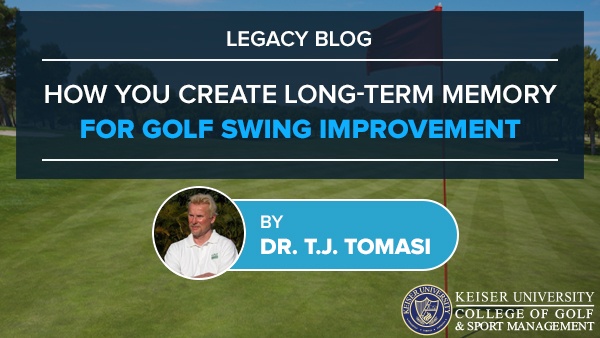How You Create Long-Term Memory for Golf Swing Improvement
 A Legacy Post by Keiser University College of Golf Senior Faculty and Director of Research Dr. T. J. Tomasi (1940-2023)
A Legacy Post by Keiser University College of Golf Senior Faculty and Director of Research Dr. T. J. Tomasi (1940-2023)
There are three steps to creating memory:
- First, you sense the experience (see, feel, hear).
- Then, it’s held in short-term memory (STM) while you evaluate what to do with it.
- Finally, you either forget it, or it goes to long-term memory (LTM), where it’s stored until you need it.
Your brain scans the world second by second, looking for threats, food, pleasure, and information about important experiences, like how to swing a golf club. Most of the data that floods your brain is filtered out during the early stages of the memory process because it is of little value to you. If you want to solidify something like a golf swing, you have to get it through the filters at stages 1 and 2 to move it to stage 3 – Long-Term Storage (LTS). Of course, it’s good that we have an effective filtration process to screen out clutter. There is a rare and debilitating condition called Hyper-Thymestic Syndrome, where nothing is forgotten; so, like the house of a hoarder, the brain is stuffed with an accumulation of lifelong clutter. Ask Jill Price, billed as ‘the woman who forgets nothing,’ and she’ll tell you that forgetting is not a fault – it’s essential to happiness.
Please remember that space in your brain is the most valuable real estate on the planet, so it’s a plus that most experiences leave no permanent trace. The question is, “What do you have to do to move your new golf swing through the filters into permanent storage?” In golf, I see it all the time – a student hits it well during the lesson and thinks they have it, but since it is only in short-term memory, it is soon wiped out to clear space – unless, of course, the student and teacher follow the laws of learning.
The first Law of Learning says that good learners pay attention. By focusing on what you are learning (say, the grip) and why it’s important, you mark the experience as intense – and research shows that experiences that are recognized as intense escape the filters and are encoded as permanent memories. Here is how it works. When you pay attention, your brain fires off electrical impulses. Neurons fire and wire together, forming networks large enough to handle the increased electrical traffic of new experiences. Thus, the more attention you pay, the more your neurons fire, and the more they fire, the bigger the networks that are devoted to your golf swing. Like a muscle that grows due to working out, when you pay attention, your neural square footage increases.
To pay attention correctly, you must focus on what you are learning and why you are learning it. This creates the intense electrical traffic necessary to carry your new golf swing from STM through the filters to LTM – a journey that can take anywhere from two days to two years, depending on how closely you follow the Laws of Learning.
Bad learners ruin the process by focusing on the ball flight instead of giving the task at hand their full attention. If you gape at where the ball goes when you are trying to learn a piece of the swing (like the proper grip), you will never produce the volumes of electrical current necessary to move your grip experience from STM to LTM – you will have had a lesson or a practice session, but you won’t have learned anything permanently.
Learn more!
Want more tips? If you want to take your game to the next level, contact our team at Keiser University’s College of Golf & Sport Management today. With our dedication and experience, together, we can elevate your game to new heights. Give us a call today at 888-644-4964.














